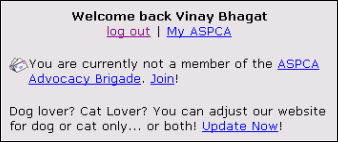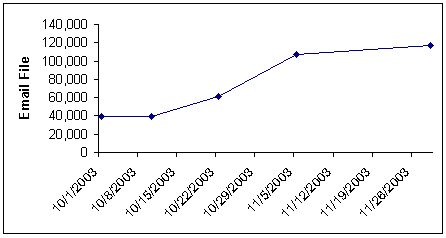|

January/February 2004
New Online Tools Transform How Nonprofits Reach, Motivate and Retain Advocates
by Vinay Bhagat, Founder and Chairman, ConvioŽ
 The primary goal of advocacy is to drive positive change in support of an organization's mission. This change may involve impacting legislation, securing funding or affecting a corporate policy. Grassroots advocacy involves influencing large groups of people to agree with an opinion or objective and getting them to help influence policy makers through media coverage, personal contact, phone calls and letters. The primary goal of advocacy is to drive positive change in support of an organization's mission. This change may involve impacting legislation, securing funding or affecting a corporate policy. Grassroots advocacy involves influencing large groups of people to agree with an opinion or objective and getting them to help influence policy makers through media coverage, personal contact, phone calls and letters.
The Internet -- specifically the advent of online advocacy and constituent relationship management tools -- has had a profound impact on grassroots advocacy. In 2001, 42 million Americans used the Internet to research public policy issues i; 23 million sent comments to public officials about policy choices; and 13 million participated in an online lobbying campaign. Key developments include:
- Easy, low cost mobilization through email
Email has enabled advocacy groups to mobilize constituents very quickly and cost-effectively. Organizations -- such as the American Society for the Prevention of Cruelty to Animals (ASPCA) -- that used to send letters to advocates have moved to a completely email-based mobilization approach. Newer cause-driven groups have started their advocacy programs with an online-only approach.
- Increased response rates through easy response mechanisms and personalization
Online response forms on Web sites recognize returning advocates, pre-fill their personal information and map legislative targets based upon each constituent's ZIP code. These forms allow a constituent to personalize the message and can automate message delivery via email or fax. Targeting messages by geography generates higher response rates. Mothers Against Drunk Driving ran a test sending a generic email appeal to one group of constituents and a personalized appeal with a specific state grade for drunk driving regulation to another group. The personalized message achieved a 155 percent higher response rate.
 Fig. 1: Personalization of advocacy appeal by recipient's state
- Increased message delivery rate through multiple channels
With advanced tools such as Convio, an organization can send messages via email, fax, mail or Web form submission on a legislator's Web site. Multi-channel message delivery options increase the message delivery rate. Increasingly, legislative offices are moving away from accepting emails and requiring submission of information through Web forms. Today's leading Internet tools enable automatic posting of advocate messages on these Web forms.
- Reach more activists
Advocacy campaigns are "viral" by nature, spreading from person to person. The Internet makes it significantly easier for activists to forward messages to others.
- Improved tracking
Traditionally, tracking the number of people taking action in a grassroots campaign has been difficult. It also has been almost impossible to know who specifically takes action, which is key for identifying the best activists. Tracking both total and individual response is much easier with new online tools.
- Better relationships, stronger loyalty
The Internet makes it easier for an organization to keep advocates apprised of the impacts of their lobbying efforts. It is very easy and cost-effective to send a targeted email to people who have taken action.
- Integrated approach to managing constituent relationships
Integrated tools like Convio enable a more congruent approach to managing relationships with new subscribers, volunteers, clients, donors, advocates and the media. For example, an organization can reach out to a constituent who is a donor, but not yet an activist, "inviting" him to join the advocacy network.

Fig. 2: Example of profile-based relationship management by the ASPCA
The Importance of Online Advocacy for Fundraisers
Advocacy can play a strong role in supporting other areas of nonprofit operations, in particular, fundraising. A grassroots advocacy program can:
- Develop strong prospects for participation in other activities
A grassroots advocacy program can be a great source of prospects for fundraising, volunteering, event participation and more. By advocating, a person shows interest and support. Advocates frequently are more receptive to additional requests for support (e.g., fundraising appeals) than "cold prospects."
In a recent campaign, the Million Mom March United with the Brady Campaign to End Gun Violence found that e-advocates (people who had signed an online petition) responded to two consecutive email fundraising solicitations at a rate of approximately three percent ii. In contrast, a reasonable response rate for a direct mail donor acquisition campaign using rented lists is one percent. At this response rate, it costs $1.15-1.50 to raise a dollar. However, using a grassroots advocacy campaign to develop a prospect list then converting that list through mail drives down the cost per dollar raised to $0.38-0.50. Converting some or all of the prospects via email instead yields an even greater cost reduction.
An organization can use online grassroots advocacy campaigns to build large prospect lists. Advocacy campaigns are "viral" by nature -- advocates generally forward messages to friends. The Million Mom March/Brady Campaign asked people to sign a petition and then forward a message to 10 others (see fig. 3). In just two months, the group nearly tripled its email list from 39,000 to 117,000 constituents. (see fig. 4).

Fig. 3: Million Mom March/ Brady Campaign petition initiative
 Fig. 4: Growth in email list during petition campaign Fig. 4: Growth in email list during petition campaign
Many groups, however, must overcome philosophical barriers. Fundraising and advocacy functions historically have been hesitant to share lists, fearing that advocates would be turned off by being asked for money and donors would be turned off by being asked to advocate. Convio's work with advocacy groups suggests this is not the case. We have seldom seen alienation of advocates when asked to donate, or alienation of donors when offered the opportunity to advocate. Case-in-point: when a national women's advocacy group made an email-based fundraising appeal to activists and non-activists (email newsletter subscribers), the activists responded at a 15 percent higher rate than non-activists, and very few activists unsubscribed (a measure of alienation) iii. Another example: 50 percent of new online donors were initially advocates who converted to donor advocates iv. Furthermore, many nonprofit groups seek to reach younger donors. Advocacy, by its nature, often attracts younger constituents who, over time, can become good prospects for development, volunteering and more.
- Grow donor/member loyalty
Nonprofits struggle with retention. Donors/members have many groups to choose among and contribute more to those with whom they have the strongest affinity. Any tactic that builds involvement or affinity also supports retention. Advocacy can be a great way to get supporters more involved; most donors can and will only give one to two times a year, but they can advocate for an organization multiple times a year.
- Reinforce the organization's brand
Branding is an important factor in driving donor preference v. Older constituents, in particular, are influenced by brand vi. An organization can build its brand through grassroots campaigns that reach many people, including prospective and current donors and the media. Such contact helps increase awareness and reinforce the organization's message.
Summary
The Internet has already transformed online advocacy for many nonprofit organizations, and advancements in online technology are pushing the potential further. Nonprofit professionals in functions other than advocacy should not only support the advocacy role within the organization, but also determine how to effectively integrate efforts for maximizing the synergy between functions. Organizations also should take advantage of new online tools that make it possible to measure and manage constituent relationships in an integrated fashion.
i Pew Internet and American Life Project, The Rise of the E-Citizen: How People Use Government Agencies' Web Sites, 4/3/02
ii Convio client data analysis Brady Campaign/Million Mom March
iii Convio client data analysis
iv Convio client data analysis regional advocacy/social services organization
v Non-Profit Brands: Friend or Foe? - Michael Birkin, 02/07/03, OnPhilanthropy.com newsletter
vi Sarah Durst, Target Analysis Group Benchmarking Trends in Nonprofit Giving, Target Analysis Year 2000 Cross-Industry Study
|
|
|


 The primary goal of advocacy is to drive positive change in support of an organization's mission. This change may involve impacting legislation, securing funding or affecting a corporate policy. Grassroots advocacy involves influencing large groups of people to agree with an opinion or objective and getting them to help influence policy makers through media coverage, personal contact, phone calls and letters.
The primary goal of advocacy is to drive positive change in support of an organization's mission. This change may involve impacting legislation, securing funding or affecting a corporate policy. Grassroots advocacy involves influencing large groups of people to agree with an opinion or objective and getting them to help influence policy makers through media coverage, personal contact, phone calls and letters. 



